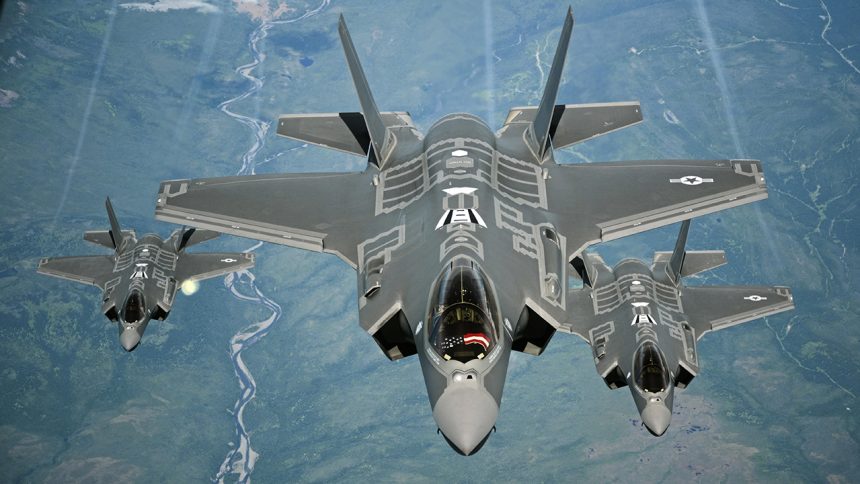On Aug. 2, 2016, the F-35A was declared “combat ready” by Gen. Hawk Carlisle, the commander of Air Combat Command. “A historic and monumental day for the program” according to Lockheed Martin; just an “Initial” capability, according to many others.
About 15 years after Lockheed Martin was awarded with a contract to develop the Joint Strike Fighter, currently known as the F-35 Lightning II, the fifth generation stealth plane, has eventually achieved the IOC (Initial Operational Capability) with the U.S. Air Force.
The first squadron declared to be operational is the 34th Fighter Squadron based at Hill AFB in Utah that was required to have at least 12 airframes ready for deployment operating as a basic close air support and air interdiction and limited SEAD (Suppression of Enemy Air Defenses) platform.
Along with other personnel, maintenance and support requirements the Air Force squadron was also expected to ensure that enough pilots are combat ready, and pass proper examination: as of Jul. 27, 21 pilots and 12 F-35A airframes could be deployed in theater.
Which one?
Well, for the moment, one of those featuring low-lethality threats or where the limited, initial capabilities of the F-35 are considered enough to counter the enemy air defenses: although the JSF has improved a lot through the years, slowly solving the long series of issues the program has experienced since the beginning (some of those still being solved), it is still far from being the aircraft advertised in the beginning.
For sure, as claimed by the head of the Air Combat Command, General Herbert “Hawk” Calisle, its stealth properties, along with the net-centric battlefield capabilities and electronic countermeasures, are the elements which are required in order to face the challenges of the dynamically changing environment of the contemporary battlefield, especially when one considers the enemy weapons systems the F-35 would be required to face.
For the type of threat faced by the U.S. combat planes in the current theaters an IOC F-35 could be more than enough to well perform in Afghanistan, Iraq or Syria, but a “real” air war against an enemy who shoots back would require an aircraft with the ability to conduct Anti-Access Offensive Counter Air, full SEAD/DEAD (Destruction of Enemy Air Defenses) missions and something more that the U.S. Air Force Lightning II is simply not ready to perform.
So, does this IOC matter? Yes and no.
Surely, after cost overruns, delays, issues of various types, it marks another achievement for the USAF F-35A but, as widely reported for instance by War Is Boring, the initial IOC requirements have been watered down to meet the deadlines.
As Defense News notes, the main concern for the Air Force is the 3F software suite of the jet, facing some instability issues, which is expected to be patched up throughout the year 2017, giving the aircraft a capacity to use new armament such as the SDBs (Small-Diameter Bombs), alongside the interface changes.
Also, Lockheed’s Autonomic Logistics Information System, ALIS 2.0.2 – an update of the logistics/maintenance suite – is not expected to be ready by the end of October, even though the Hill AFB personnel stated that the ALIS issue was not a “limiting factor”.
So, in spite of the media hype following the IOC, coherent with the usual PR support that surrounds every F-35 achievement, there is still much room for improvements, development and true operational testing.
The F-35 is now going to take a path of operational deployments, in clearly defined stages. First the Red Flags, and then – inevitably – the jet is going to become a part of the “Theater Security Packages” sent to Europe and Asia.
Some claims also emerged that within 18 months Lightning II would be stationed at RAF Lakenheath (but not permanently – this would happen around 2021, and the jets would rather complement than replace the F-15s stationed there), which would also mean that Mach Loop low-level operations could also be expected within that period, as well as some “hop-like” deployments around the continental Europe.
The prospects of development assume that Hill AFB is going to become a home for two more operational F-35 squadrons, with a view of Burlington Air National Guard Base in Vermont becoming the second operational base — and the first Air National Guard base — to host the F-35.
Burlington is going to use 18 F-35 airframes replacing its F-16 jets. Next up, 24 F-35 jets would be stationed in Alaska, around 2020 – at the Eielson Air Force Base in Fairbanks, as Defense News reports, forming an added capability, not replacing any assets stationed in the northernmost US state.
Three more bases are to be selected soon, with fifth and sixth belonging to the ANG, while the seventh one would be established in one of the bases that currently host F-16s or A-10s: Homestead Air Reserve Base in Florida, Whiteman Air Force Base in Missouri, Davis-Monthan Air Force Base in Arizona or Naval Air Station Joint Reserve Base Fort Worth in Texas.
Summing up, the much troubled and costly F-35 has grown: probably a bit more than the detractors want you to believe and probably less than both LM, the U.S. armed forces and other operators want you to believe. Hence, there is still much work to do, but we’re probably on a good path.
Written with Jacek Siminski
Related articles

















